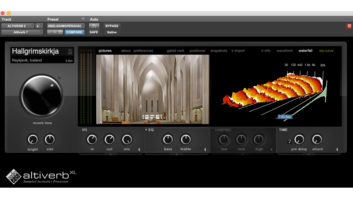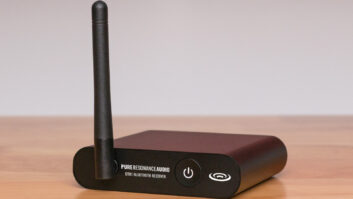The ability to sample the reverb of an environment and then use that sample to recreate the location’s reverb in your studio is an amazing engineering feat. Sony’s DRE-S777 is capable of this, but its power comes with a hefty price tag (nearly $10,000) and the rack unit itself is equally hefty (over 33 pounds). Altiverb, created by the Dutch company Audio Ease (which also makes VST Wrapper and Rocket Science Bundle), offers an alternative to the DRE-S777 by harnessing the power of an Apple G4 processor to create a sampling reverb plug-in. At $495, Altiverb competes with the DRE-S777 in terms of sonic quality at a 20th of the price and, because it’s software, it’s virtually weightless.
The CD-ROM I received from Audio Ease came with Version 1.1 software. While this version worked well for the most part, it was plagued by occasional processor overload peaks, which affected its performance. Audio Ease suggested I update to Version 1.4, a reportedly more stable build, and the problem disappeared. Version 1.4 had not yet been released at the time of this review, so I was able to download it at a secure Web page set up by Audio Ease. However, by the time you read this, all registered users will be able to download it directly through the company’s Website (www.audioease.com).
Altiverb was first released as a MAS plug-in for MOTU’s Digital Performer. I tested it with Digital Performer 3.02 using both a single-processor 400MHz and dual-processor 800MHz Apple G4 computers. Altiverb requires nothing less than a G4 to operate, and Audio Ease recommends a minimum of 30 MB of free system RAM allocated to the host program. By the time you read this, VST, RTAS and HD TDM versions of the plug-in should be available. Copy protection is via challenge and response.
VIEW OF THE VERBS
Despite the advanced processing power Altiverb packs, the plug-in’s interface is streamlined and simple to understand. Among its more conspicuous controls is a large silver dial to adjust the reverb decay. More precisely, this dial trims the reverb sample, called an impulse response, by applying an exponential decay. (Remember, because the impulse response is sample-based, you can’t make it longer than the initial sample’s length.) There is a control for changing pre-delay, which can be set to positive or negative values. A positive value delays the reverb return, while a negative value delays the dry signal, causing the reverb to begin before the original sound (a neat effect). Independent dials are available for wet and dry levels, giving you more control over your wet/dry ratio than a single wet/dry mix knob.
The plug-in has its own built-in scrapbook to illustrate pictures of the actual space that was sampled and notes on the current preset specifications. Most of the stock presets include microphone-placement diagrams and recording information, along with interior and exterior photos of the location. Double-click on the images and they blow up to their full size in a separate window. Custom pictures can be added to any preset by simply dropping an image in the Preset folder. (The program recognizes JPEG, GIF, PICT and TIFF file formats.) To see the newly added image among the preset photos, reboot the host program. The scrapbook’s preset specifications page is automatically generated by Altiverb, and includes each impulse response’s name, the name of its parent folder, length and sample rate.
Altiverb comes in a variety of configurations to suit your processing needs. On a mono channel, the choices are mono to mono, mono to stereo, and mono to quad. The choices for a stereo channel are stereo to stereo, stereo to quad, stereo-mix to stereo, and stereo-mix to quad. The stereo-mix settings combine a stereo source’s left/right channels that feed a mono signal to the plug-in; this configuration uses less processing power than a true stereo-to-stereo instantiation. When a quad plug-in is selected, a menu to assign the rear outputs to the appropriate buses in your system becomes active. Many of Altiverb’s factory presets were recorded in quad, and though they sound fine as stereo plug-ins, they sound spectacular in quadraphonic sound; sitting in the middle of a surround system and listening to my tracks through one of Altiverb’s quad presets is inspirational.
The CD-ROM only comes with nine sampled spaces, but they all sound great. All of the environments were recorded from several different positions using omni and cardioid microphones at 48 kHz, 24 bits. Each recording, which is made up of a set of impulse responses (left, right, center, rear left, rear right), equals a space’s preset. The Utrecht Conservatory Chapel that was recorded from center of house using cardioids sounded particularly sweet on acoustic guitar and voice. There’s even a set of impulse responses from car interiors — a Ford Transit van and a Fiat Tipo — that are fun. Additional impulse responses are available for download at Audio Ease’s Website, and users can also post and share their own sampled environments.
SHOOTING THAT SAMPLE
To create and store your own samples, generate an initial impulse response by running a sine wave sweep or firing a starter pistol in the selected environment and then record the result. A sine wave sweep audio file accompanies the program. If you want to use a starter pistol, then you’ll need to provide this yourself. However, though a starter pistol is a lot more convenient than hauling studio monitor speakers and a playback device for the sweep to a location, this latter setup is said to yield much higher-quality impulse responses. Besides, pulling out anything that even remotely looks like a weapon in a public place is never a good idea.
An application called the IR Pre-Processor, which also ships with Altiverb, is used to extract the dry impulse sound from the wet impulse return. It reads SDII audio files (I wish it also recognized .AIFF and .WAV) and converts them during processing to a proprietary format for Altiverb. The Pre-Processor is simple enough to use: Just tell it to subtract either a sine wave sweep or a starter pistol, depending on what you used, and feed it your samples. The only tricky part of the operation is making sure that all of your initial impulse-response files are properly named; if a file is misnamed, it may appear to the Pre-Processor to be missing, which results in an abrupt halt to processing. After a new impulse response is added to the Impulse Responses folder, the host application must be restarted in order for Altiverb to see the new preset. Altiverb’s Impulse Responses folder does not need to be kept on your system drive because the plug-in can address it from a different drive.
Details on how to position your speakers and microphones are nicely explained in the manual, so I won’t discuss that here. Suffice it to say, the quality of your initial recordings is directly related to the quality of your final presets; if you’re going to sample your own space, don’t skimp. My friends and I used Alesis M1 Active studio monitors, a MOTU 828 and Digital Performer, and a matched stereo pair of Neuman KM184 microphones to record the swimming pool space beneath the Hollywood Athletic Club in Los Angeles. We also sampled a vintage AKG BX10 spring-reverb unit. In both instances, the sine wave sweep was used and recordings were at 48 kHz, 24-bit. (You can check out our BX10 example on Audio Ease’s site.)
Altiverb is not timid when it comes to devouring processing power. In fact, it is certainly the most processor-hungry plug-in I have encountered to date. My 400MHz computer was hard put to run two simultaneous, mono-to-stereo instances of Alti-verb. Sometimes trying to change presets on either instantiation caused Digital Performer to crash. However, Altiverb performed much better on the dual-G4 800MHz machine, which handled two stereo-to-stereo and one mono-to-stereo instance comfortably.
A word of warning: For those of you with Digidesign hardware, Digi’s Direct I/O ASIO driver is not very efficient and tends to bog down Digital Performer, resulting in poor real-time processing performance. MOTU’s interfaces, such as the FireWire 828 or PCI-324 card with an interface, do not suffer from this problem, and give a much better performance all around. Also, because Altiverb’s presets are at 48 kHz, 24 bits, loading them into a 44kHz 16-bit session takes a little longer.
It is truly amazing what software engineers can accomplish on today’s computers. Altiverb is a perfect example of this type of impressive software, a plug-in that fully utilizes the G4’s power, is well-designed and certain to be a valuable addition to any studio. Though it pushes the G4 to the wall, especially in its “no-latency” mode (its default setting is “high latency,” which sounds fine for most situations), central processors will only become more powerful and Altiverb will only shine brighter. If you dream of owning a sampling reverb unit but can’t afford the Sony machine, then check out Altiverb. You can’t go wrong for $495, especially considering that this plug-in can emulate more than just reverbs; P.A.’s, microphones, hardware EQ, vintage tape-delay units — you get the idea. Altiverb works well and sounds great, and I found that sampling a location’s ambience for use in my personal computer is a very satisfying experience.
Audio Ease bv, Lagenoord 26, 3513 GW Utrecht, the Netherlands; 31 30-243-3606; fax 31 30-243-8500; www.audioease.com.
Special thanks to Victor Owens, Jeff Hutchins and Scott Greer for all of their help field testing Altiverb, and Patrick at the Hollywood Athletic Club for accommodating our field recording session.







